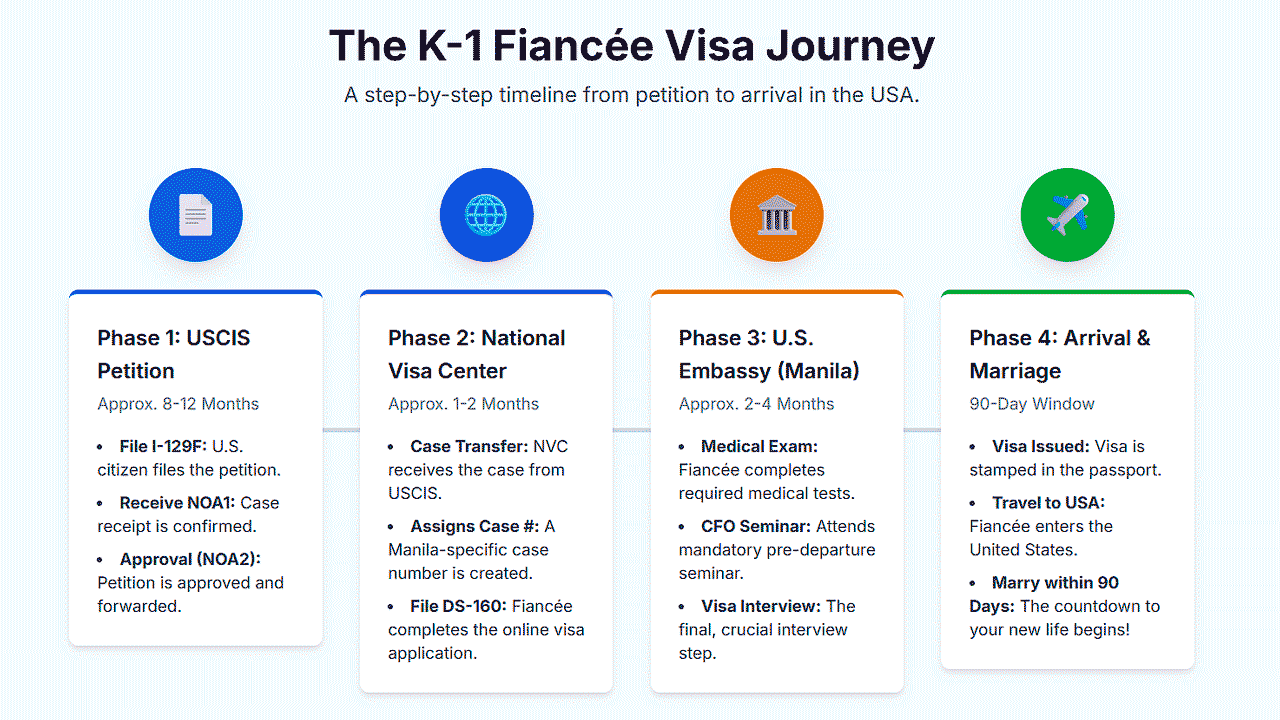K-1 Fiancée Visa Guide for a Filipina Bride (2025 Edition)

You’ve done it. After countless messages, video calls, and perhaps even a life-changing trip, you’ve found the woman you want to spend the rest of your life with in the beautiful Philippines. The connection is real, the love is profound, and now only one major hurdle remains: bringing her home to the United States. This is where the K-1 Fiancée Visa journey begins.
Navigating the U.S. immigration system can feel like trying to solve a complex puzzle in the dark. The forms are numerous, the requirements are strict, and the stakes are incredibly high. But don’t be discouraged. Thousands of couples successfully complete this process every year. With the right information and a clear, step-by-step plan, you can confidently navigate this path and begin your new life together.
“The longest journey begins with a single step.” This guide is your first step toward transforming your long-distance relationship into a lifelong marriage.

What is a K-1 Fiancée Visa? The 90-Day Promise
The K-1 visa is a nonimmigrant visa specifically for the foreign-citizen fiancé(e) of a United States citizen. Its primary purpose is to allow your Filipina fiancée to travel to the U.S. with the explicit intention of getting married. Once she arrives, you have a 90-day window to tie the knot. This 90-day period is strict and cannot be extended.
K-1 Visa Eligibility Requirements
Before you begin, both the U.S. Citizen (Petitioner) and the Filipina fiancée (Beneficiary) must meet these fundamental requirements.
U.S. Citizen Petitioner Requirements:
- You must be a U.S. Citizen. The K-1 is not for Green Card holders.
- You must be legally free to marry (single, divorced, or widowed).
- You must have physically met your fiancée in person at least once in the last two years.
- You must both sincerely intend to marry within 90 days of her arrival.
Filipina Fiancée Beneficiary Requirements:
- She must be a citizen of the Philippines.
- She must be legally free to marry.
- She must be admissible to the United States, with no disqualifying criminal or immigration history.
- She must pass a required medical examination.
The “Meet in Person” Rule is Non-Negotiable. This is why services like romance tours and singles travel are not just for vacation; they are a crucial step in fulfilling the legal requirements for a K-1 visa. Keep photos, ticket stubs, and passport stamps from your trip—they are vital evidence.
The Complete K-1 Visa Timeline: A Step-by-Step Breakdown
The K-1 process can be broken down into four major phases. While processing times can change, the sequence of steps remains the same. Patience is key.
Phase 1: The Petition with USCIS
This is where it all starts. As the U.S. citizen petitioner, you will be the one to file the initial paperwork.
- File Form I-129F, Petition for Alien Fiancée. This is the foundational document of your case. You will need to gather extensive supporting evidence to submit with it, including proof of your U.S. citizenship, proof of your in-person meeting, evidence of your ongoing relationship, and signed statements of intent to marry.
- Receive a Notice of Action (NOA1). Within a few weeks of filing, you’ll receive a receipt notice from USCIS confirming they have your case.
- Wait for Approval (NOA2). This is typically the longest waiting period. USCIS will review your petition. If they need more information, they may issue a Request for Evidence (RFE). Once approved, you’ll receive a Notice of Action 2 (NOA2).
Phase 2: The National Visa Center (NVC) Stage
After USCIS approves your I-129F petition, they transfer your case to the Department of State’s National Visa Center. The NVC prepares your case for the embassy interview.
- The NVC assigns a case number. You’ll receive a welcome letter with a new case number for the Manila embassy.
- Your Fiancée Files Form DS-160. This is the Online Nonimmigrant Visa Application. Your fiancée will complete this extensive form online, providing her biographical information.
- The NVC forwards the case. Once all initial processing is complete, the NVC sends your case file to the U.S. Embassy in Manila, Philippines.
Phase 3: The U.S. Embassy in Manila
This is your fiancée’s part of the journey. She will be the one completing these steps in the Philippines.
- Schedule the Medical Exam. Your fiancée must complete a medical examination with an embassy-accredited physician at St. Luke’s Medical Center Extension Clinic (SLEC).
- Attend the CFO Seminar. She must attend a guidance and counseling seminar from the Commission on Filipinos Overseas (CFO) and obtain a CFO certificate. This is a mandatory government requirement.
- The Embassy Interview. This is the final major step. Your fiancée will bring all her original documents to the interview. A consular officer will ask questions to confirm the legitimacy of your relationship.
Phase 4: Visa Issued and Travel to the USA
If the interview is successful, the consular officer will approve the visa. Her passport will be taken for visa stamping and returned to her via courier. With her K-1 visa and a sealed packet of documents (which she must NOT open), she can now travel to the United States. The 90-day countdown to your wedding begins the moment she enters the country.
The Financial Side: Costs and the Affidavit of Support
The K-1 visa process involves significant government fees and other expenses. Furthermore, you must prove that you can financially support your fiancée. This is done by showing proof of income that meets at least 125% of the U.S. poverty guidelines for your household size. For more details, see our complete guide on the Affidavit of Support.
| Expense Item | Estimated Cost (USD) |
|---|---|
| Form I-129F Filing Fee | $535+ |
| Embassy Visa Application Fee (DS-160) | $265 |
| Medical Examination Fee | ~$335 |
| CFO Seminar Fee | ~$10 |
| Total Estimated Base Cost | ~$1,145+ |
Note: Fees are subject to change. This does not include flights or document costs. Always check the official USCIS and Department of State websites for current figures.
After Arrival: Marrying and Adjusting Status to Get the Green Card
The K-1 visa is just the ticket to get your fiancée into the country. After you marry within the 90-day window, she must apply for a green card (permanent residency) by filing Form I-485, Application to Adjust Status. This is a separate process with its own forms and fees. Only after this is approved will she become a lawful permanent resident. For a detailed walkthrough, view our guide to adjusting status.
Frequently Asked Questions (K-1 Visa for Filipinas)
1. How long does the entire K-1 visa process take in 2025?
Currently, the process can take anywhere from 12 to 18 months, or sometimes longer. The USCIS petition review is the longest phase. It is essential to file a complete and well-documented application to avoid delays.
2. Can my Filipina fiancée work in the U.S. on a K-1 visa?
No, not immediately. After she arrives, she can apply for a work permit (EAD) by filing Form I-765 at the same time as her I-485 adjustment of status application. It typically takes several months for the work permit to be approved.
3. What happens if we don’t marry within 90 days?
The K-1 visa expires, and your fiancée will be out of status. She will be required to leave the United States. There is no extension for the 90-day marriage requirement.
4. What if my income is too low to prove financial support?
If you don’t meet the financial requirements, you can use a joint sponsor. This person must be a U.S. citizen or green card holder who meets the income requirements and agrees to be financially responsible for your fiancée.
5. What is the difference between a K-1 Fiancée Visa and a CR-1 Spousal Visa?
A K-1 is for a fiancée to come to the U.S. to get married. A CR-1 is for a spouse who is already married to a U.S. citizen. The CR-1 process is often longer, but your wife arrives in the U.S. as a permanent resident with a green card. Check our K-1 vs. CR-1 comparison to decide which is right for you.
6. Can I include my fiancée’s children on the K-1 petition?
Yes. Her unmarried children under 21 can be included. They will receive a K-2 derivative visa to travel with her.
7. What is IMBRA and how does it affect my petition?
The International Marriage Broker Regulation Act (IMBRA) requires you to disclose certain criminal history on the I-129F petition. It also means the agency that introduced you must comply with specific regulations. See our IMBRA compliance guide for more info.
Your Future Wife Awaits
The K-1 visa journey is a testament to your love and commitment. It is a path paved with paperwork, but the destination is a life shared with your Filipina wife. Stay organized, be patient, and focus on the incredible future you are building together. For a complete toolkit covering every stage of your relationship journey, from dating to daily life as a married couple, our Mabuhay Welcome Kit is your essential companion.



